Sat at the foot of Kadifekale, sandwiched between the hillside and the streets of Kemeraltı is Izmir’s ancient agora. When we wrote about the Lycian and Roman ruins of Xanthos, we said that around many of Turkey’s archaeological sites, modern daily life continues. Nowhere is this more evident than at the agora.
Here we are, in the centre of Turkey’s third largest city, surrounded by multi-storey car parks, high rise hotels and offices, shopping precincts, residential neighbourhoods – and here’s a sizable ancient site right in the middle of it all; a site packed with clues about 8,500 of years Izmir’s history when the area was known as Smyrna.
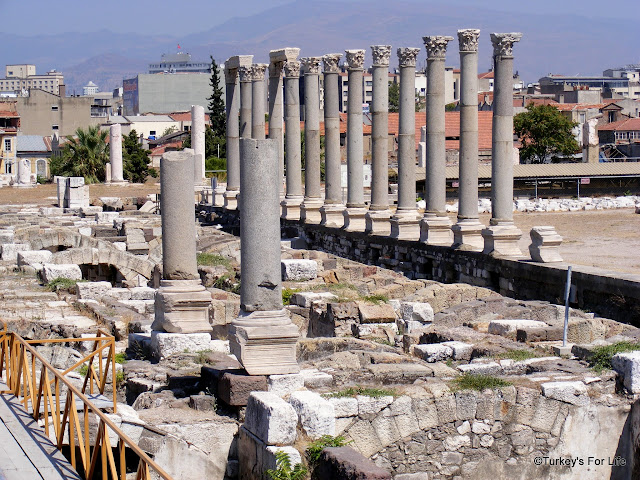
To spend six days in Izmir and not go to the agora would have been neglectful of us and, after going inside to look around, we would have missed out big time had we decided not to bother visiting. The agora has a lot of competition when it comes to Turkey’s Roman sites but that doesn’t make it any less interesting for today’s visitor – not that you’d notice that fact on arrival at the site.
The above photo is the view from the perimeter fence as you arrive at the entrance. There was a smattering of tourists there, poking their cameras through the wire fencing to get photos and there was an archaeological dig in progress. Aside from the archaeologists, there wasn’t a soul beyond the fence. The automatic assumption was that the site must be closed because of the dig, so we took a couple of photos and decided to head on up to Kadifekale.
As we followed the perimeter fencing we spotted a ticket booth with a lady sitting inside. A beaming smile appeared on her face as we approached. Do all tourists really just poke their camera through the fence and not bother going inside? “5 lira to go in,” she said. 5 lira and the place was empty. Just bizarre!
And to be honest, we thought we’d seen all there was to see just by scaling the perimeter (maybe that’s what everyone else thinks, too) and so Barry waited outside while I wandered inside. At this point, I was paying 5 lira just to get a couple of photos from different angles and then I was coming straight back out again. But there’s more to Izmir’s agora than meets the eye.
It was a strange feeling entering this ancient site all alone (the archaeologists were on their lunch break). Corrugated roofing, where the digs are taking place, covered some sections, and hornets were dancing around my feet as I photographed the columns. Where had the hornets come from – can’t say they’re my favourite insect in the world – and why were they there?
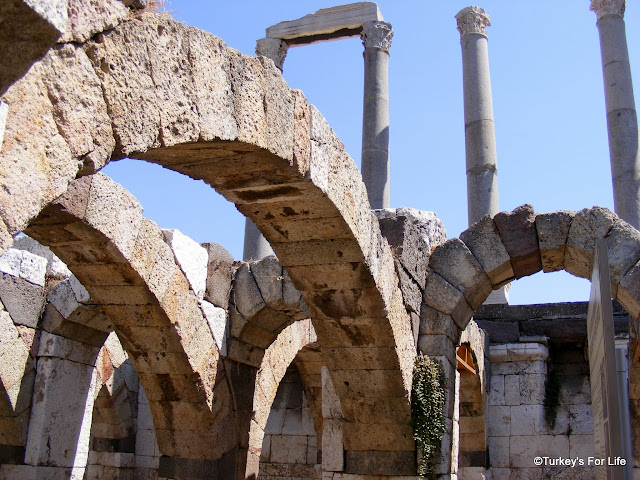
Information boards and arrows guided me along a wooden walkway and then down a flight of steps. All of a sudden, the photo taking tourists and the ticket booth were out of sight and I was completely alone in a world of fantastically intact stone arches. It’s not what you can see from the ground that makes Izmir’s agora so interesting – and everyone, except me, was missing out.
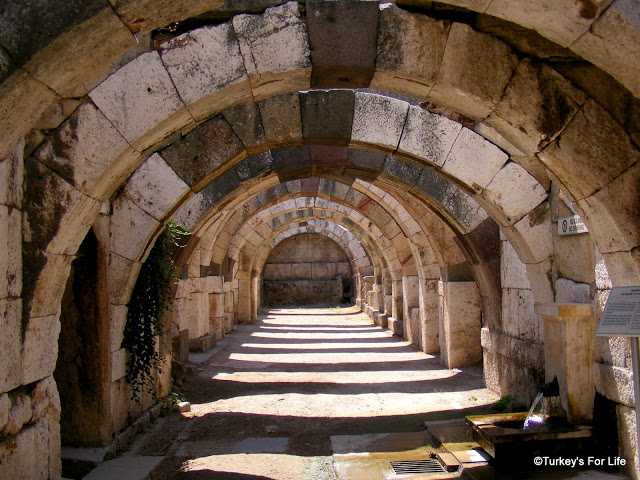
Having a place completely to yourself, and being underground – a mixture of being slightly spooked but also complete freedom of imagination, wondering what life was like around the agora thousands of years ago. And then the answer to why this site is a hornet haven – fresh running water spilling from water taps in the walls…
…and running along narrow channels carved into the ground. This is a fresh water supply that has constantly run through the agora since the Roman period (4th century BC) and still does to this day. What’s fascinating is that archaeologists are still unsure as to where the source of this water supply is. Just amazing! It’s thought the water was stored in cisterns and used in the workshops around the agora.
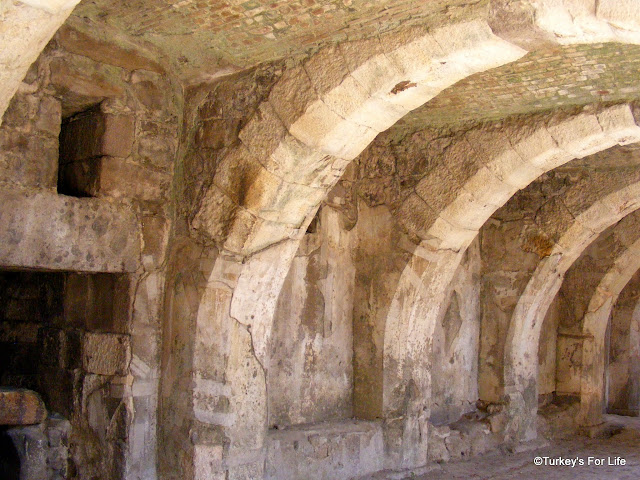
At the far end of the site, the walls become fantastically thick – maybe a metre – and the archways are closed. There were still information boards and arrows so I decided to continue, despite the increasing lack of natural light. It was with a bit of trepidation that I passed through a small doorway which was pitch black (you can get an idea of this just on the left of this photo) but fortunately, there really was a light at the end of the tunnel; a light that I walked very quickly towards!
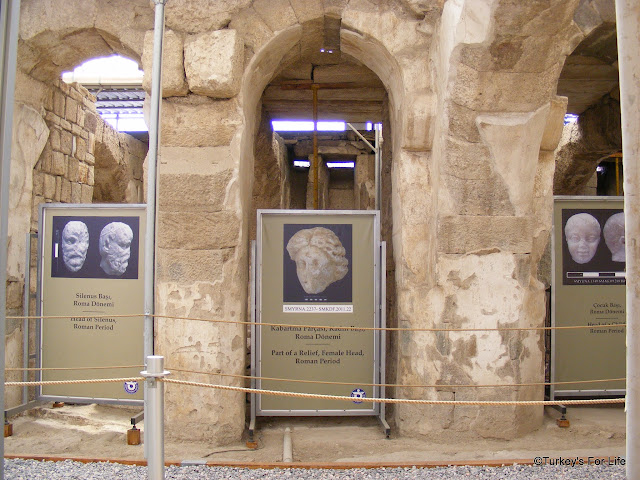
And this is what was there to greet me. This area was completely fenced off and I had to zoom in to get these photos. There are still digs going on in this section but it also looks like there’s going to be a more organised museum-type layout in the future, detailing what’s been unearthed.
From here, I was led outside via the northwest gate of the basilica. Scan your eyes to the left of this shot and the hill in the background. The Turkish flag you can just make out in the distance marks the top of Kadifekale, our next port of call. Can’t say I was relishing the climb, but it was our last day in Izmir and the only outstanding item on our Izmir-must-do list. Time to leave the agora, find Barry and climb ourselves a hill. Click this link to read our post about Kadifekale.
While the agora in Izmir might not be top of your agenda for archaeological sites in Turkey, digs are current and it’s a site that’s changing all the time. Smyrna was an important centre along with nearby Ephesus (Efes) and Pergamom (Bergama) and was home to the likes of Homer and Alexander the Great – so expect lots more exciting finds in the area. As it stands now, it’s easily worth your time and 5 TL of your cash!
Izmir Agora – Useful Information:
- Entrance to the site (Sept 2012) was 5 TL (about £2)
- The site is signposted around Kemeraltı. Walk along the main road, Eşrefpaşa Caddesi and follow the site fencing around the corner to 920 Sokak.
- If you want to walk up to Kadifekale afterwards, continue past the site, take a right onto 806 Sokak and just head uphill until you’re at the top!
- Archaeologists from Dokuz Eylül University are currently working on the site and are uncovering new parts of ancient Smyrna all the time. Artefacts and structure date from the Hellenistic, Roman and Byzantine periods. Sections of the site were closed off to visitors and, while digs are active, it looks as though different sections will reopen and close at regular intervals.
- According to this Hürriyet article, a protective perimeter wall is set to be built and the agora will become a centrepiece for Izmir. It deserves to be.
Read more: http://www.turkeysforlife.com/2013/03/izmir-ancient-agora.html#ixzz2N1nBEIkX


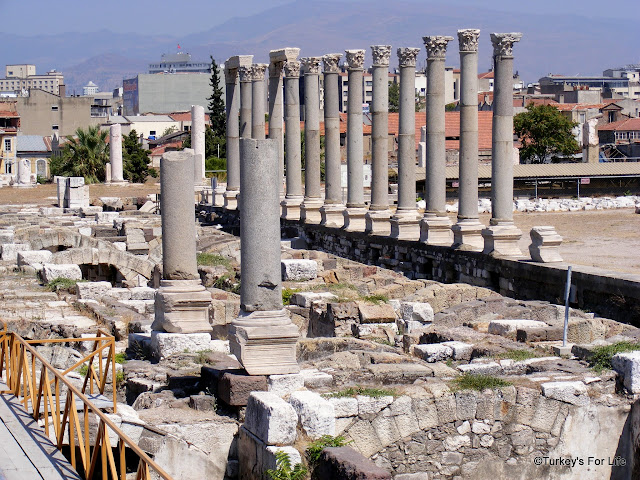
Leave a Reply